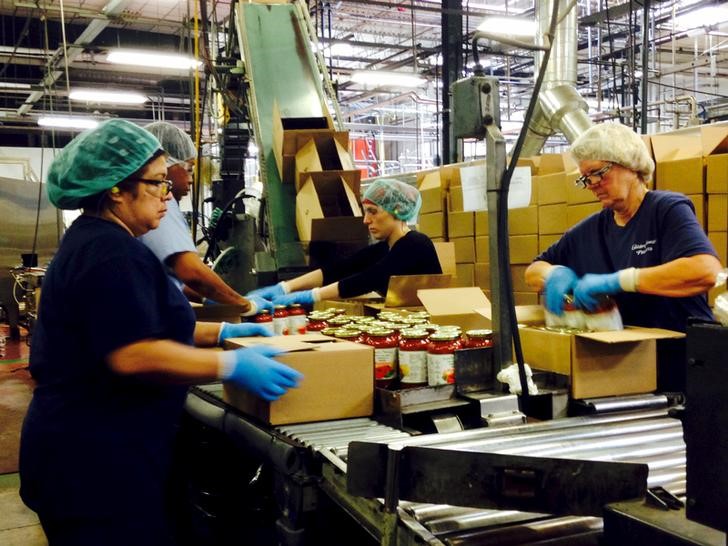By Lucia Mutikani
WASHINGTON (Reuters) - U.S. producer prices increased more than expected in March, boosted by rising healthcare and food costs, pointing to a steady buildup of inflation pressures.
Most economists believe that strengthening inflation will prompt the Federal Reserve to raise interest rates three more times this year. The U.S. central bank increased borrowing costs last month and forecast at least two more rate hikes in 2018.
Producer prices have risen solidly since January, largely driven by the services components. Economists expect these increases to spill over into the consumer price index (CPI) and the Fed's preferred inflation measure, the personal consumption expenditures (PCE) price index.
"This pipeline price pressure will feed into consumer prices soon and will ultimately prompt the Fed to hike interest rates an additional three times this year," said Paul Ashworth, chief U.S. economist at Capital Economics in Toronto.
The Labor Department said on Tuesday its producer price index for final demand rose 0.3 percent last month after increasing 0.2 percent in February. That lifted the year-on-year increase in the PPI to 3.0 percent from 2.8 percent in February.
Economists polled by Reuters had forecast that the PPI would climb 0.1 percent last month and 2.9 percent from a year ago.
A key gauge of underlying producer price pressures that excludes food, energy and trade services rose 0.4 percent last month, advancing by the same margin for a third straight month.
The so-called core PPI increased 2.9 percent in the 12 months through March, the biggest gain since August 2014, after climbing 2.7 percent in February.
U.S. Treasury prices fell on the inflation data while the dollar pared losses to trade marginally lower against a basket of currencies. Stocks on Wall Street were trading higher after Chinese President Xi Jinping promised to cut import tariffs, easing investor concerns about rising U.S.-China trade tensions.
BROAD PRICE RISE
March's broad-based increase in wholesale prices supports views that inflation will pick up this year.
Those expectations were boosted by a survey from the NFIB on Tuesday showing the share of small businesses planning to increase prices reaching its highest level since 2008 in March.
The survey also showed the proportion of businesses raising wages to attract or retain workers was the largest in more than 17 years.
A tightening labor market, a weak dollar and fiscal stimulus in the form of a $1.5 trillion tax cut package and increased government spending are seen pushing inflation toward the Fed's 2 percent target this year.
The Fed's preferred inflation measure, the PCE price index excluding food and energy, increased 1.6 percent in February after being stuck at 1.5 percent for four straight months. The Labor Department will publish March CPI data on Wednesday.
The price of services increased 0.3 percent in March, rising by the same margin for a third consecutive month. Services, which accounted for 70 percent of the increase in the PPI last month, were boosted by a 0.4 percent rise in the cost of outpatient care.
Those costs feed into the core PCE price index. There were also increases in the cost of airline tickets, and cable and satellite subscriber services.
But prices of wholesale apparel, footwear and wireless communications services fell last month.
Prices for goods rose 0.3 percent, after slipping 0.1 percent in February. They were lifted by a 2.2 percent jump in wholesale food prices. That was the biggest increase since April 2014 and followed three straight monthly declines.
Wholesale food prices last month were driven by a surge in the cost of unprocessed fish, chicken eggs and fresh and dry vegetables. Gasoline prices dropped 3.7 percent after falling 1.6 percent in February.
"Some of these price pressures likely reflect stronger global growth in the first quarter and U.S. dollar weakness in the past 16 months," said Chris Low, chief economist at FTN Financial in New York. "The PPI is much more sensitive to both capacity constraints and the dollar than the CPI. Nevertheless, there is no denying the rising trend in wholesale costs."
In a separate report on Tuesday, the Commerce Department said wholesale inventories increased a bit less than initially estimated in February, but still suggested that inventory investment would contribute to economic growth in the first quarter after being a drag on output in the prior period.

Wholesale inventories rose 1.0 percent instead of the 1.1 percent jump it reported last month. That was the biggest increase since October 2013. Stocks at wholesalers increased 0.9 percent in January.